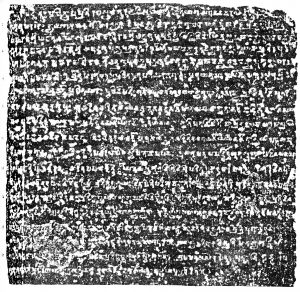Prinsep (1836)
661
Prinsep, James. (1836). Facsimiles of various Ancient Inscriptions, lithographed by James Prinsep, Secretary As. Soc. &c., Journal of the Asiatic Society of Bengal, 5, pp. 340-349, 482-486, 554-561, 657-660, 724-731, 795.
Mill (1837)
1-17
Mill, W. H.
(1837). Restoration and Translation of the Inscription on the Bhitárí Lát, with critical and historical remarks, Journal of the Asiatic Society of Bengal, 6, pp. 1-17.
Prinsep (1858)
240-248
Prinsep, James. (1858). Essays on Indian Antiquities, Historic, Numismatic, and Palaeographic, of the late James Prinsep, F.R.S., Secretary to the Asiatic Society of Bengal, to which are added his Useful Tables Illustrative of Indian History, Chronology, Modern Coinage, Weight Measures, etc., edited, with notes, and additional matter, by Edward Thomas, Late of the Bengal Civil Service, Member of the Asiatic Society of Calcutta, London, and Paris. In Two Volumes - Vol. I. with numerous illustrations. Edited by Edward Thomas. London: John Murray.
ASIR 01 (1880)
97-99
Cunningham, Alexander. (1871). Four Reports made during the years 1862-63-64-65, Volume I (Archaeological Survey of India Reports 1). Calcutta: Superintendent of Government Printing.
Bhau Daji (1875a)
59-62
Bhau Daji
Bhau Daji. (1875). Revised Translation of the Inscription on the Bhítari Lát, The Journal of the Bombay Branch of the Royal Asiatic Society, 10, pp. 59-62.
Bhandarkar (1885)
199-222
Bhandarkar, Ramkrishna Gopal. (1885). The Date of Patanjali. A Reply to Professor Peterson, Journal of the Bombay Branch of the Royal Asiatic Society, 16, pp. 199-222.
Peterson (1885)
189
Peterson, P. (1885). Note on the Date of Patanjali, Journal of the Bombay Branch of the Royal Asiatic Society, 16, pp. 181-189.
Indraji (1885)
349-356
Indrajî, Bhagwânlâl
Indrajî, Bhagwânlâl. (1885). Transcript and Translation of the Bhitarî Lât Inscription, The Journal of the Bombay Branch of the Royal Asiatic Society, 16, pp. 349-356.
Fleet (1888)
52-56, no. 13
Fleet, J. F. (1888). Inscriptions of the Early Gupta Kings and Their Successors. Calcutta: Superintendent of Government Printing.
Divekar (1919)
112-118
Agrawal, Jagganath. (1946). The Puṣyamitras of the Bhitari Pillar Inscriptions, Indian Historical Quarterly, 22, pp. 112-118.
Bhandarkar (1929)
213, no. 1549
Bhandarkar, Devadatta Ramakrishna. (1929). A List of the Inscriptions of Northern India in Brahmi and its derivative Scripts, from about 200 A. C. (Appendix to Epigraphia Indica volumes XIX to XXIII). Calcutta: University of Calcutta.
Agrawal (1940)
60
Nath, J. (1940). Epigraphic Notes. In: Proceedings of the Indian History Congress. Fourth Session: Lahore, 1940. Lahore: Indian History Congress Association.
Basham (1955)
366-369
Basham, A. L. (1955). The Date of the End of the Reign of Kumāra Gupta I and the Succession after his Death, Bulletin of the School of Oriental and African Studies, 17, no. 2, pp. 366-369.
Sharma (1957)
148-50
Sharma, Dasharatha. (1957). The Interpretation of "ā-kumāram manushyaih" of Sakandagupta's Bhitarī Inscription and Connected Problems. In: Proceedings of the Indian History Congress. Nineteenth Session, Agra, 1956. Patna: Indian History Congress.
Thakur (1961)
279-286
Thakur, Upendra. (1961). A Note on the Pushyamitras of the Bhitari Pillar Inscription, Indian Historical Quarterly, 37, pp. 279-286.
Pandey (1962)
99-102
Pandey, Raj Bali. (1962). Historical and Literary Inscriptions (The Chowkhamba Sanskrit Studies, 23). Varanasi: Chowkhamba Sanskrit Series Office.
Chhabra (1963)
543-549
Chhabra, Bahadur Chand. (1963). Some Observations on the Bhitari Inscription of Skandagupta, Journal of Indian History, 41, pp. 543-549.
Chhabra (1965)
362-371
Chhabra, Bahadur Chand. (1965). Beauties of the Bhitari Inscription of Skandagupta. In: Felicitation Volume (A Collection of Forty-two Indological Essays) presented to Mahamahopadhyaya Dr. V. V. Mirashi. Edited by Deshpande, G. T. et al. Nagpur: Vidarbha Samshodhan Mandal.
Sircar (1965)
(vol. 1) 321-324, bk. III, no. 28
Sircar, Dines Chandra. (1965). Select Inscriptions Bearing on Indian History and Civilization. Volume I: From the Sixth Century B.C. to the Sixth Century A.D. (Second Edition). Calcutta: University of Calcutta.
Agrawal (1968)
325-327
Agrawal, Jagannath. (1968). The Status of Skandagupta’s Mother, Annals of the Bhandarkar Oriental Research Insitute, 48/49, pp. 325-327.
Mirashi (1980a)
86-92
Mirashi, Vasudev Vishnu. (1980). Bhitari Stone Inscription of Skandagupta, Journal of the Epigraphical Society of India, 7, pp. 86-92.
Bhandarkar (1981)
312-317, no. 31
Fleet, J. F., and Bhandarkar, D. R. (1981). Inscriptions of the Early Gupta Kings (Revised Edition). Edited by Bahadur Chand Chhabra and Govind Swamirao Gai. New Delhi: Archaeological Survey of India.
Agrawala (1983)
no. 36
Agrawala, Prithvi Kumar. (1983). Imperial Gupta Epigraphs (गुप्ताधिराजलेखमण्डल). Ancient Indian Epigraphical Sources (प्रत्नाभिलेखसंहिता) X.1. Varanasi: Books Asia.
Agrawal (1986a)
63
Agrawal, Jagannath. (1986). Researches in Indian Epigraphy and Numismatics. Delhi: Sundeep Prakashan.
Goyal (1993)
209-222
Goyal, Shri Ram. (1993). गुप्तकालीन अभिलेख/Guptakālīna Abhilekha (Inscriptions of the Gupta Age). Jodhpur: Kusumanjali Prakashan.
Bakker (2005)
1: lxii, 2: 248-251
Bakker, Hans Teye. (2005). Commemorating the Dead. A Note on Skandagupta’s Bhitarī Inscription, vss. 8–12. In: Revealing India's Past: Recent Trends in Art and Archaeology. Prof. Ajay Mitra Shastri Commemoration Volume. 2 vols. Edited by R. K. Sharma and Devendra Handa. New Delhi: Aryan Books International.
Willis (2009)
144-149
Willis, Michael D. (2009 [digitally corrected edition 2019]). The Archaeology of Hindu Ritual: Temples and the Establishment of the Gods. Cambridge: University Press.
